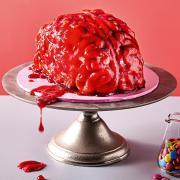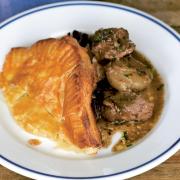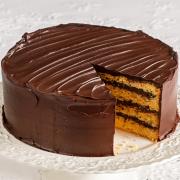With taste and table appeal, these enticing Easter recipes are sure to be crowd pleasers.

Italian stuffed bread with baked eggs
(serves 10-12)
This flavoursome bread makes the perfect starter or accompaniment
INGREDIENTS
180ml warm water
28g active dry yeast
1tbsp sugar
180ml milk
500g bread flour, plus more for dusting
1tbsp sea salt
80ml olive oil
1 large egg
1tsp water
4 eggs
For the pesto:
Leaves and soft stems from 85g watercress, roughly chopped
5 cloves garlic, peeled and grated
150g grated Parmesan or other hard cheese
Zest of one lemon
55g pine nuts, toasted
120ml extra virgin olive oil
METHOD
In the bowl of a stand mixer fitted with a paddle attachment, combine the warm water, yeast and sugar. Mix at low speed until just combined (about 30 seconds). Leave to stand for 5 minutes or until the mixture is frothy.
Heat the milk in a saucepan over a medium-low heat until tiny bubbles form at the edge of the pan. Do not allow to boil. Set aside and cool to room temperature.
Once cooled, add to the mixer along with the olive oil and salt. Mix at a low speed until just combined. Add the flour a quarter at a time, mixing after each addition on a medium-low speed.
Change the paddle attachment over to the hook, ensuring any dough is scraped off, and put back into the bowl. Mix on low speed for 1 minute, then increase speed to medium for 5-6 minutes, or until dough is smooth and elastic.
Lightly oil a large mixing bowl and place the dough inside. Lightly oil a piece of clingfilm cover the dough, oiled side down. Cover this with a cloth and put in a warm place to prove for around 1 hour, or until the dough has doubled in size.
Make the pesto by adding the watercress, garlic, cheese, lemon zest, and pine nuts to a processor. Pulse until pureed, then blend continuously while adding the olive oil. Scrape down the sides and blend for another 30 seconds to make sure everything is combined.
Preheat the oven to 200°C and line a large baking sheet with parchment paper. Make an egg wash by whisking the egg and teaspoon of water, and prepare a large square of parchment to shape the bread on.
Lightly flour a work surface, turn out the proved dough and cut it into three equal pieces. Use a lightly floured rolling pin to roll out the first piece to a 12 inch/30cm square and 3mm in thickness. Use a spatula to scoop a third of the pesto onto the dough and spread evenly, leaving a border uncovered on the edge closest to you.
Brush exposed border with egg wash, then roll the dough into a tube from the furthest edge towards you as tightly as you can, then pinch the seam closed with your fingertips. Gently roll the tube back and forth over the work surface until it spreads lengthwise to about 20 inches/50cm long. Cover with cling film while you repeat with remaining dough and pesto.
Line up the tubes on parchment paper and make a lengthways slash in each roll, cutting a deep slit halfway down the depth of the tube, taking care not to cut all the way through.
Roughly measure the centre point of the tubes and working towards you from the centre, plait the tubes by crossing one of the outer tubes gently over the middle one, then cross the other outer tube up and over the new middle one. Repeat, working your way down to the end so that half the tube is braided. Then turn the parchment around and plait the other side from the centre to the end. Carefully join up the ends so that the plaited dough forms a ring, then pinch firmly together to complete the circle. Use the parchment paper the dough is resting on to transfer the whole thing to your lined backing tray.
Make four equally spaced dents for the eggs in between the strips of the plait. Gently position the eggs one by one, pressing down carefully to avoid breaking them. Lightly oil a piece of cling film to cover the bread. Allow to prove for around 30 minutes.
Uncover and brush with the remainder of the egg wash. Place in the centre of the oven and bake for 10 minutes, then reduce the oven temperature to 180°C and bake for an additional 45 minutes or until the bread is a warm brown and sounds hollow if you tap the bottom.
Remove from oven, cool for 10 minutes on the baking tray, then transfer to a cooling rack and allow to come down to room temperature before serving.
Recipe courtesy of watercress.co.uk

Maple lamb pie recipe
(serves 4)
This rich pie is a tasty alternative to roast lamb
INGREDIENTS
3tbsp olive oil
500g diced lamb
1 red onion chopped
1 glass of red wine
3tbsp pure maple syrup (preferably dark syrup for its robust taste)
4 garlic cloves thinly sliced
500g potatoes, peeled, cubed
2 carrots, peeled, sliced
3tbsp tomato paste
4tbsp gravy powder
1 cubes of beef stock
1 litre water
2tbsp Worcestershire sauce
2tbsp fresh rosemary, chopped
1tbsp fresh thyme, chopped
2tbsp cornflour
1 puff pastry sheet, ready rolled
1 egg, lightly beaten
Salt
Pepper
METHOD
Preheat oven 180°C.
Grease a 4 to 5cm deep, 20cm (base) pie dishes.
For the filling, heat 1tbsp oil in a large saucepan over medium-high heat, add the lamb and cook, stirring occasionally, for 5 minutes or until browned. Transfer to a plate.
Heat the remaining 2tbsp of oil in a pan over medium-high heat.
Add the chopped onion and garlic. Cook for 3 minutes or until soft.
Add the potatoes, carrots, rosemary and thyme. Cook for 5 minutes or until browned.
Add the wine, maple syrup, tomato paste and gravy powder.
Return lamb to pan then add stock cube, water and Worcestershire sauce. Increase heat to high. Bring to the boil then reduce to a simmer, covered, and stir occasionally for 2 hours or until the lamb is tender. Season with salt and pepper to taste.
Combine cornflour and 2 tablespoons of cold water. Add to the mixture. Simmer for 1 minute. Remove from heat and cool.
Pour the lamb mixture into the dish and place the puff pastry sheet on the top.
Brush the pastry with the beaten egg then bake for 20 minutes.
Recipe courtesy of maplefromcanada.co.uk

Easter chocolate nest cake recipe
The perfect centrepiece for your Easter table!
INGREDIENTS
For the cake
100g unsalted butter
275g Tate & Lyle Light Brown Sugar
2 eggs
175g plain flour
1tsp baking powder
1tsp bicarbonate of soda
200ml full-fat milk
50g cocoa powder
For the icing
25g cocoa powder
5tbsp boiling water
6 chocolate flakes
A handful of chocolate mini eggs
300g Tate & Lyle Icing Sugar
175g unsalted butter, softened / at room temperature
3 Cadbury's creme eggs
METHOD
Grease and line a 20cm loose-bottomed cake tin with baking parchment. Preheat your oven to 180C / 350F.
Cream the butter and sugar until soft, then beat in the eggs.
Mix the flour, baking powder and bicarbonate of soda in a separate bowl.
Mix the milk and cocoa powder together, whisking as best possible. The cocoa powder will likely create a film and sit on top of the milk, but that’s fine.
Sift the flour mixture into the wet ingredients, then add the milky cocoa in. Using a rubber spatula, fold all the ingredients together until you get a smooth batter then spoon into the prepared tin. Bake for approximately 1 hour until a skewer inserted into the centre comes out clean.
Remove from the oven and leave to cool for 10 minutes in the tin, before turning out on a wire rack.
To make the chocolate fudge icing, mix the cocoa powder with the boiling water to make a smooth paste.
Cream the butter to soften it, then sift in icing sugar, beating until light, well combined and smooth. Add cocoa paste, scraping down the sides of the bowl to ensure everything is incorporated. Whisk until uniform in colour and smooth enough to spread.
Once the cake has cooled completely, use a sharp serrated knife to slice widthways in half. Turn half upside down so you have the smooth bottom on top, and the crumby inside facing downwards on your cake plate or stand. Add about a third of the frosting to the bottom half, spreading well to the edges.
Top with the second half and spread the remaining buttercream over the top and sides.
Break up the chocolate flakes and scatter over the top of the cake, pressing lightly into the buttercream. Add the mini eggs and crème egg.
Recipe courtesy of wearetateandlylesugars.com


























